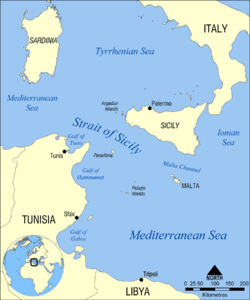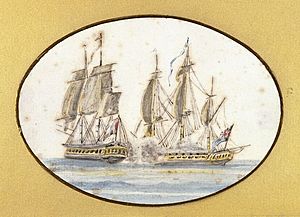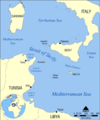Action of 27 June 1798 facts for kids
Quick facts for kids Action of 27 June 1798 |
|||||||
|---|---|---|---|---|---|---|---|
| Part of the French Revolutionary Wars | |||||||
|
Location of the engagement |
|||||||
|
|||||||
| Belligerents | |||||||
| Commanders and leaders | |||||||
| Captain Edward Foote | Captain G. F. J. Bourdé | ||||||
| Strength | |||||||
| Frigate HMS Seahorse | Frigate Sensible | ||||||
| Casualties and losses | |||||||
| 2 killed, 16 wounded | Heavy casualties, Sensible captured | ||||||
The action of 27 June 1798 was a small but important sea battle. It happened between a British ship and a French ship. The battle took place in the Strait of Sicily in the Mediterranean Sea. This fight was part of a bigger war called the French Revolutionary Wars.
The French ship, a frigate named Sensible, was on a special mission. It was carrying wounded soldiers and valuable items back to France. These items had been taken after the French captured Malta. The British ship, HMS Seahorse, was a frigate searching for the main French fleet.
Captain Edward Foote led the British Seahorse. He spotted the French Sensible and chased it for 12 hours. The Sensible was slower and had fewer experienced sailors. The British ship won the battle, capturing the French frigate. This victory gave the British important information. They learned that the French planned to invade Egypt.
What Led to the Battle
In May 1798, a large French fleet set sail from Toulon. Their destination was a secret. This fleet included 22 warships and 120 transport ships. More ships joined them as they sailed south. Their real target was Egypt. French General Napoleon Bonaparte thought Egypt would be a good place. From there, they could attack British India.
The British navy had not been in the Mediterranean for over a year. So, Bonaparte's fleet sailed south without trouble. They passed Sicily and arrived at Malta on June 9. Malta was ruled by the Knights of St. John of Jerusalem. Bonaparte wanted to control Malta. He believed it was key to controlling the middle of the Mediterranean Sea.
The Knights' leader, Ferdinand von Hompesch zu Bolheim, would not let the French fleet into the harbor. So, Bonaparte launched a big invasion. The Knights did not fight much. But local Maltese troops fought for a day. After the city of Mdina fell, the Knights gave up. They were promised money and land in France.
After taking Malta, Bonaparte took control of its army and navy. He also took a lot of wealth from the island. This included property from the Roman Catholic Church. Much of it was sold. Other valuable items were sent to France. Wounded soldiers, like General Louis Baraguey d'Hilliers, also went back.
On June 19, Bonaparte split his forces. He left 4,000 men to guard Malta. The rest of the fleet continued towards Egypt. One ship was chosen to go back to France. This was the 36-gun frigate Sensible. Captain G. F. J. Bourdé was in command. Many of its regular crew were replaced. Freed Maltese galley slaves took their place.
The British Royal Navy had heard about the French plans. They sent a small group of ships to the area. Rear-Admiral Sir Horatio Nelson led this group. His ships were hit by a bad storm. They had to stop for repairs. The storm also scattered his smaller scouting ships, called frigates. This made it hard for Nelson to find the French fleet.
More British ships were sent to help Nelson. But these frigates also spread out too much. They could not find either the main British or French fleets. Both fleets were sailing quickly towards Egypt.
The Sea Battle
One of the British ships looking for the French was HMS Seahorse. Captain Edward Foote commanded this frigate. The Seahorse was officially a 38-gun ship. But it actually carried 46 guns. These included powerful 32-pounder carronades. These were heavy, short-range cannons.
Captain Foote was sent to join Nelson's fleet. He was also carrying extra sailors for one of Nelson's ships. On June 26, Seahorse was sailing near the coast of Sicily. At 4:00 PM, a lookout spotted a ship. Foote quickly realized it was a French frigate. He got his ship ready for battle.
The French ship was Sensible. It was sailing from Malta towards Toulon, France. Captain Bourdé knew his ship was overloaded. It also had fewer experienced sailors. So, he turned his ship south. He hoped to escape during the night.
For 12 hours, Sensible tried to get away. But Captain Foote's Seahorse kept gaining on it. At 4:00 AM on July 27, Foote brought Seahorse alongside Sensible. He opened fire with his heavy guns.
Many of the galley slaves on the French ship ran below deck. This left the ship exposed. Within eight minutes, Sensible was badly damaged. Captain Bourdé tried to ram the British ship. But Foote easily avoided it. The French frigate was hit 36 times in its hull. Its masts were also badly damaged.
The French suffered many casualties. Between 18 and 25 men were killed. Another 35 to 55 were wounded. The British Seahorse had only light damage. Two men were killed, and 16 were wounded. This included the First Lieutenant, Wilmot.
After the Battle
Captain Foote took the valuable items and prisoners from Sensible. He sent the captured ship, with a small crew, to the British fleet. This fleet was with Earl St. Vincent. Among the items taken were French naval code books. There was also information about where Bonaparte's invasion fleet was going.
Foote immediately sailed for Alexandria, Egypt. He was soon joined by another British ship, HMS Terpsichore. This ship was also looking for Nelson. They reached Alexandria on July 21. They found the French fleet already there. But Nelson was nowhere to be seen.
Foote and the other captain disguised their ships. They made them look like a French frigate and a captured ship. This tricked the French. They were able to observe the French ships in Aboukir Bay. Then, they sailed along the African coast. They were still searching for Nelson.
Nelson was at Syracuse getting supplies. On July 25, he sailed east. He learned about the French invasion of Egypt from a Turkish governor. Nelson then sailed directly south. He arrived at Aboukir Bay on August 1. He fought and won the Battle of the Nile. He never met Foote or got his important information before the battle. Seahorse returned to Alexandria on August 17. They found out Nelson had won the battle almost three weeks earlier.
Earl St. Vincent needed more frigates. When Sensible arrived, he quickly made it a British warship. He took sailors from his other ships to man it. Sensible served with St. Vincent for a year. Then, it was sent back to Britain in November 1799. It was later used as a military transport ship. It was wrecked off Ceylon in 1802.
Among the treasures from Sensible was a fancy brass cannon. It had been given to the Knights of St. John by King Louis XIV of France. There was also a model of a galley made of silver. These items were sold. The money from the sale was given to the crew of Seahorse. This was their prize money.
General d'Hilliers and the other French officers were taken to Britain. They were later allowed to return to France. There, d'Hilliers and Captain Bourdé faced a court martial. The French Minister of Marine, Étienne Eustache Bruix, thought they gave up too easily. He criticized their "talents and courage." But after General d'Hilliers defended himself, both officers were cleared of wrongdoing.
Captain Foote was praised for his success. Lieutenant Wilmot, who brought the captured Sensible to the British fleet, was promoted. Foote later commanded Seahorse near Naples. He became involved in a disagreement about the execution of leaders in 1799.
Images for kids
See Also
- Mediterranean campaign of 1798
- French occupation of Malta
- Battle of the Nile





